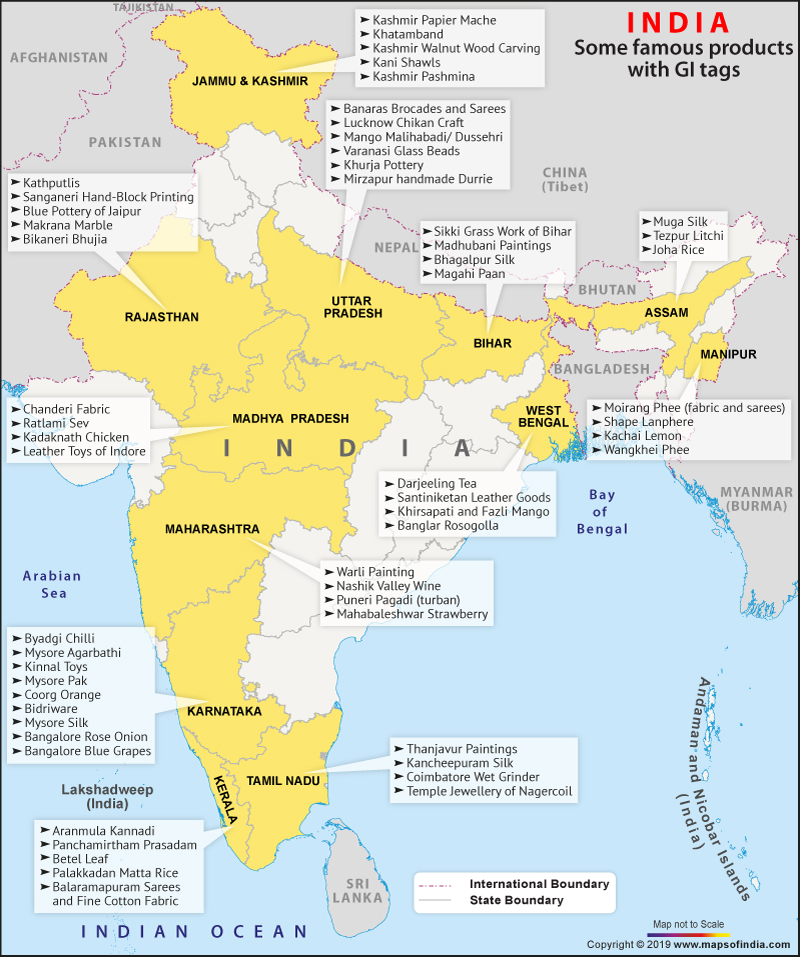GI Tags
2020 MAR 10
Mains >
Economic Development > Indian Economy and issues > IPR Conventions

Why in news:
Several states in India have been in tussle over GI tag for various products, such as Rasagola and Basmati rice.
TYPES OF IP RIGHTS:
Intellectual property is divided into two categories:
- Industrial Property includes patents for inventions, trademarks, industrial designs and geographical indications.
- Patent: an exclusive right granted for an invention that provides a new way of doing something, or that offers a new solution to a problem. Protection is granted for a limited period, generally 20 years.
- Trademark: a distinctive sign that identifies certain goods or services produced or provided by an individual or a company. It helps consumers identify an authentic product or service.
- Industrial design: It refers to the ornamental or aesthetic aspects of an article. To be protected, these designs must be new or original.
- Geographical Indication: It is a sign used on goods that have a specific geographical origin and posses qualities or a reputation due to that place of origin.
- Copyright covers literary works, films, music, artistic works and architectural design. Rights related to copyright include those of performing artists in their performances, producers of phonograms in their recordings, and broadcasters in their radio and television programs.
Geographical Indications of Goods Act, 1999:
- The Law seeks to provide for the registration and better protection of geographical indications related to products.
- A Geographical Indications Registry with all India jurisdiction operates in Chennai.
- The registration of a geographical indication is valid for a period of 10 years and can be renewed periodically for an additional 10 years each.
- The use of geographical indications is not limited to agricultural products. They may also highlight specific qualities of a product that are due to human factors found in the product’s place of origin, such as specific manufacturing skills. Eg: Coimbatore wet grinder
- In case of violation, there is a penalty of imprisonment (6 months to 3 years) and a fine of between Rs.5,000 and Rs.2 lakh.

Benefits of GI Tag:
- Recognition: GI tag helps the producers to differentiate their products from competing products in the market. It enables the producers to build a reputation and goodwill around their products, which helps in export earning, promotion of tourism, cultural heritage and national identity.
- Protection: Geographical indications grands legal right to the exclusive use of the product to a specific group. Thereby it prevents unauthorized use and the right to obtain relief in case of its infringement.
- Preservation: Legal protection to GIs protect the livelihood of the people. This can go a long way in sustaining the crafts and preserving the age-old methods of their production.
- Branding: GI makes branding possible in the global market. It cuts out intermediaries, help GI allows genuine producers to capture the market and helps manufacturers raise profits.
- Rural development: GI tags enhance the reputation of products as well as the places from which they are created, which are mostly cottage industries or rural areas. This helps generate more income, better market access, employment generation and boosts tourism.
Issues and limitations:
- Difficulty in identification: India is a diverse country where there are thousands of products and producers that would qualify for a geographical indication. Also, it is difficult to properly demarcate their geographical boundaries or authenticity of claims. Hence, granting GI recognition becomes daunting task. This is why conflicts such as that between Odisha and West Bengal over Rasagola occurs.
- Weak enforcement: Like other patent acts, the GI Act also lacks effective enforcement. Violations are rife because of poor enforcement of rights and court cases that could run on for years. This is a sore point, particularly for individuals and small-scale industries that have limited resources to seek judicial remedies.
- Lack of awareness: There has been a lack of awareness among the consumers as well as the producers on the importance of GI tags. There is marginal participation by the common masses in most of the GI applicant bodies, resulting in a majority of stakeholders being kept in the dark about the GI protection.
- Sensitive nature: Granting GI recognition very often results in resentments from many. This is seen in the case of Basmati rice, where Madhya Pradesh has been unsuccessfully attempting to include its Basmati growing regions into the GI recognized Basmati growing areas of Indo Gangetic plains.
- Limited after services: The scope of GI has not been exploited to the fullest extent here. Unlike in other countries, as there are no proper mechanisms to monitor what happens after a product is given this tag. Also, the Indian statute has no provisions mandating quality checks on the GI products.
Way forward:
- Effective enforcement is crucial for enhancing the IP regime in India. The key challenge is to sensitize the enforcement officials and the Judiciary to take up IP matters, at par with other economic offences by bringing them under their policy radar.
- To increase awareness, educators need to incorporate IP into their curriculum discussions. Also, awareness drives such as ‘Creative India, Innovative India’ should be expanded to reach the common masses in the remotest areas of the country.
- State governments have a significant role in promoting GI recognition. States can come forward with their own GI policy and also allocate funds for promoting products with GI tags.
PRACTICE QUESTION:
Q. Discuss the significance of Geographical Indication tags to India?

